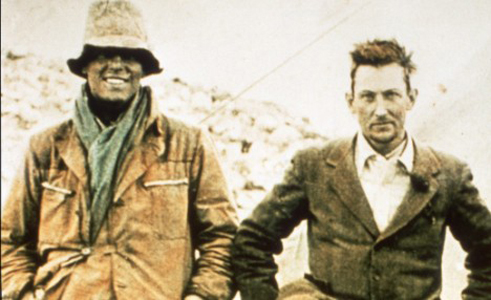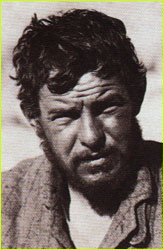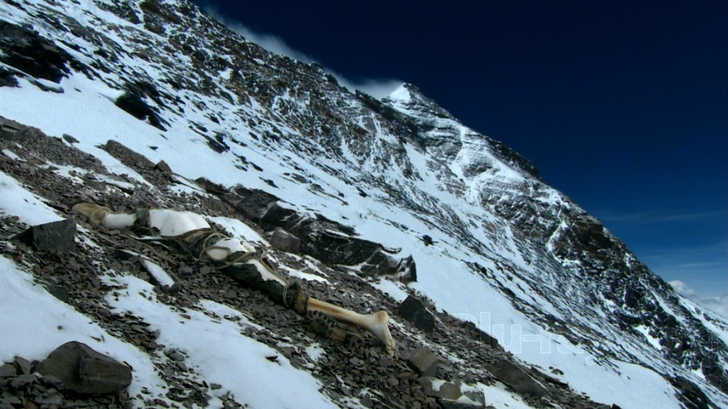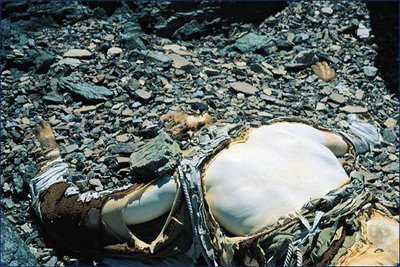On June 6, 1924, two haggard members of the British Everest Expedition, George Mallory and Andrew Irvine, left their frozen canvas tent on the wind-whipped side of Mount Everest and made a final push to reach the summit. It was the culmination of months of suffering, unrelenting effort, and danger, and the two men were confident that victory finally lay within their grasp. For Mallory, an experienced and tenacious alpinist, this was his last chance to achieve what had eluded him in previous summit attempts in 1921: to be the first man to reach the peak of the world’s most formidable mountain. Having lost the race to be the first to reach the North and South Poles, British exploratory energy had invested much in Everest expeditions. But Mallory and Irvine never returned. On June 21, 1924, The Times of London published a telegraph from another team member announcing their death. It said only, “Mallory and Irvine killed on last attempt.”
The mystery of what had happened to them would continue to haunt Everest exploration ever since.
George L. Mallory (right). Victory, he felt, was finally within his grasp.
Fast forward to 1998. An American climbing enthusiast, Larry Johnson, emailed a twenty six year old German geology student and amateur climber named Jochen Hemmleb. Hemmleb had an encyclopedic knowledge of Everest expeditions. He had studied the subject intensely for many years and possessed an impressive archive of Everest arcana. He had published some of his writings on Everest exploration on a website for climbers, and had engaged in dialogue with other climbers in the website’s forum section. Johnson and Hemmleb began a regular correspondence and eventually put together the idea of forming a commercial expedition to Everest for the purpose of investigating the fate of Mallory and Irvine. After countless false starts and frustrations, funding was finally secured, team members were selected, and the expedition finally moved forward in 1999. They called it the Mallory and Irvine Research Expedition.
As far as was possible, the plan was to retrace the steps of Mallory’s ill-fated 1924 summit attempt. Over the decades, randomly discovered clues from climbers of different nationalities had suggested the presence of Mallory and Irvine in different places near the summit: a tent pole here, an ice axe there. But nothing was known with certainty. How had they perished? Where were they? Beyond these questions lay the tantalizing possibility that the two men had actually reached the summit. If they had, the world would have to acknowledge that Sir Edmund Hillary, reaching the summit in 1953, was not the first.
Mallory had had a formidable reputation among mountaineers; thirty eight years old in 1924, he was generally recognized as the finest climber of his day. Tall, determined, a natural leader with restless energy, and possessed of a powerful physique, he was one of those urbane explorer-adventurers that England seemed to produce in abundance in the 19th and early 20th century. He was of an age where his strength of body was tempered by the practical prudence befitting his years. Readers should remember that this was an era before the high-tech comforts we take for granted: before Gore-Tex, before labor-saving advanced mountaineering communications equipment, before synthetic materials, and before all the other comforts that modern explorers enjoy. Even bottled oxygen, that sine qua non of modern high-altitude mountaineering, was a novelty in 1924: Mallory himself only grudgingly accepted it after long debate.
Mallory and his men climbed Everest wearing woolen sweaters, leather boots, and clothing made from natural fibers. Looking at their “primitive” equipment now, with the knowledge of what climbers now take for granted, one is astonished at the toughness of these men. These were real men, not overgrown boys. And these were cultured men: in the frozen wastes of Everest, they would recite passages to each other from King Lear and MacBeth to pass the time and maintain morale. It was a different age. One can only grimace at the thought of what these men would make of our modern youth, with their marshmallow bodies, hover hands, neckbeards, and acquiescence to feminism. Take a good look at the faces in the header photo for this article, showing the members of the 1924 British expedition. And take a good look at this photo of one of its members, Theodore H. Somervell. Somervell coughed up the lining of his throat during the summit attempt, and kept right on going.
Theodore Howard Somervell, a tough and relentless member of the 1924 British Everest Expedition.
The 1999 expedition had a general idea of how Mallory and Irvine had approached the summit, and were operating on the assumption that they might have fallen somewhere near the Northeast Ridge of Everest. Eventually the expedition members approached the Northeast Ridge, a perilous route from which some climbers over the years had fallen to their deaths. Team member Conrad Anker, acting on intuition, began to search on a low slope near the Rongbuk Glacier, traversing the rocky ground for signs of an ancient corpse. He eventually saw a bleached-white form lying on the rocky ground wearing a hobnailed boot, and approached cautiously. It was a body, it turned out, that had been holding fast to the side of Everest for seventy five years.
The body of George Leigh Mallory as it was discovered in 1999
Most of the clothing had frayed away from the body, but the frozen white flesh had been preserved in Everest’s unique environment. “The clothing was blasted from most of his body, and his skin was bleached white. I felt like I was viewing a Greek or Roman marble statute,” said team member Dave Hahn. An examination of the name tag under the corpse’s sweater revealed the name G. Mallory. The team members stood before the corpse in awe, hardly believing that they were viewing the remains of their fallen hero. What fortitude, what tenacity, in comparison to the over-equipped and pampered climbers of today! There was an inexpressible poignancy to the scene, a sense of kinship with those who had gone before them and participated in the great struggle to conquer the mountain.
With some effort, the team members searched the ground for artifacts and buried the body. The expedition had succeeded in discovering the fate of George Mallory, but the question of whether he or Irvine had actually reached the summit of Everest remained unanswered. No one really knows. Enthusiasts debate the issue with intensity, but it remains an unsettled question.
But what is beyond all dispute is the courage and tenacity of Mallory, Irvine, and the other members of the 1924 expedition. Laboring under conditions of extreme adversity, they set a high-water mark for Everest exploration that would not be matched for decades, until Sir Edmund Hillary achieved the first confirmed ascent of the summit in 1953. Actually reaching the summit has everything to do with raw guts and brute force, combined with favorable weather. The essence of masculine energy is breaking through barriers, overcoming obstacles, and achieving great things through unconquerable willpower and applied skill. To dream great things, to plan great enterprises, and to fight for their realization: are these not the secret flames that burn with unquenchable passion at the core of our being?
Look again, I ask you, at the fallen grandeur of George Mallory. Even in the repose of death, there is a supreme and silent dignity, and a heroic majesty, in this alabaster figure, preserved in startling whiteness and suspended in time, still grasping at the side of the mountain which had claimed his life so long before. He lies there still, every inch a man.
His fallen form chants to us its own regal poetry, to which we can add not a single verse.
Read More: The Return Of A King




Good way to end this one.
“‘The opposite of manliness isn’t cowardice; it’s technology” Taleb
Now we have bottled oxygen etc. but not the will. Ironically, I am reading this on the internet.
Technology is a product of masculinity. Women never have, nor never will, be the pioneers that produce the revolutionary changes in society.
Maybe as men we are supposed to push even further with technology. Elon Musk wants to put a man on Mars. Even if he fails, he is a great man.
There is no “maybe” about it. 5.5% of commercialized patent holders are women*. I’m sure that is all environmentally induced and has nothing to do with biological differences of course…
* Source: Communications of the ACM: “The Reporting the Gap on the Patent Gender Gap”. 2013.
We could have put men on mars 40 years ago:
http://www.amazon.com/The-Case-Mars-Settle-Planet/dp/0684835509
Elon, as much as I like what the guy is doing, is actually “failing” at what men in the 1960s could have done with maybe 10 more years of gov’t funding. I say “failing” in quotes, because it’s actually incremental success, just repeated.
Right because women have never invented or contributed to anything in technology. Tell that to computers, the circular saw, signal flares, submarine telescopes and lamps, the original murphy bed (called a folding cabinet bed which happened to be invented by a black woman), invisible glass, liquid paper (similar to White Out), windshield wipers, kevlar, the dishwasher, the apartment fire escape, a woman discovered hydrogen, a woman discovered radiation sickness and it’s effects as well as radium, a woman discovered nuclear fission, but yeah women never contributed anything to technology or anything.
Computers? Who’d a thunk it….. maybe Alan Turing would have something to say about that one. Submarine telescope? Oh a periscope! Invented by a woman? Really? Wouldn’t be much need for windshield wipers without a car would there….I believe Marie Curie made all her discoveries with her husband and other male scientists. Just say a little thank you to the boys for all the work they put into inventing and maintaining the modern world in which you live……. you’re welcome…..
“Tell that to computers . . .”
Ada Lovelace never designed, never mind invented, a computer in her life. Her chief contribution was some observational notes she made while translating the work of a man.
” . . .a woman discovered hydrogen . . .”
They also get confused, yet fail to fact check.
“liquid paper”
White paint marketed to secretaries, very amusing.
Disclaimer of Bias: I once named a cat Hypatia.
Remember guys. Lets all have a nice little meeting about diversity and inclusion.
When we are done only the females and minorities will get promoted.
but..EVERYONE gets a nice little gold sticky star!
“Just say a little thank you to the boys for all the work they put into
inventing and maintaining the modern world in which you live…….
you’re welcome…..”
They never say thank you. They just try to pretend they invented or in most cases just spit in your face like children. Such ingratitude.
Marie Curie was the real deal but she was the exception. An aberration. I bet she ( Curie) had a high T count explaining her brilliant , inventive “male” like brain
Don’t reply to women. Otherwise you may be banned.
I realized my error nearly as soon as I had made it. Kinda like that time I picked up a hot soldering iron from the wrong end.
These are stories this website needs. Goes well with the talk of the ancient world. High brow and inspiring.
Agreed and there’s no shortage of these types of men. I’d like to
suggest a story on Nungesser and Coli, two Frenchmen who attempted to
fly the Atlantic before Lindbergh. They never arrived in New York but
like with Mallory and Irvine there’s still exists the question of
whether they made it accross.
I believe a theme is that there is a shortage of these types of men alive today. The celebrities are almost all trash, as well as the leaders. It’s up to us to improve ourselves to achieve the near-impossible goals that we decide upon. The stories of past greats are a testament to themselves and to the fact that they wished their future generations to be just as remarkable!
Risk taking has evolved to facilitate sex outside of committed, monogamous relationships. Mallory was married with three children he needed an adventure. He must have been bored to death with his wife and children. Death was a relief!
He was lucky he lived in times when man could just fuck off and do something frisky. No wonder men volunteered to go to war.
“No wonder men volunteered to go to war.”
That’s one thing they shouldn’t have done.
And I thought I was tough this weekend for continuing on with a long ocean paddle after being gored in my foot by a stingray. Those guys were studs. I find articles like this to be very inspiring.
What?? Why on earth would you do such a thing? Clearly the high-altitude and freezing were preserving him. Burying him will only hasten his own decomposition and you’ll just be burying him in rocks anyway, so with the next rockslide, he’ll be exposed again. I would have insisted that his body either come back down the mountain (nearly impossible to accomplish), or just leave it be.
Fantastic story, I’d never heard this one. I’m shocked that his body was so well preserved on the mountain.
Good comments and questions. My authority for this story came from the account of the expedition’s own written record, which was published in book form in 1999 under the title “Ghosts of Everest: The Search for Mallory and Irvine.”
The high altitude of Everest acts as something of a “freeze-drying” environment. Mallory’s corpse was preserved for so long because of the lack of carrion eaters (vultures, insects, etc.) at that altitude, as well as the extreme cold and dryness.
As the dry, hot sands of Egypt scrupulously preserve the dessicated remains of the pharaohs, so the unique environment of Everest preserves in physical form those souls who would attempt to conquer her.
As for why the team members buried Mallory: they did it out of respect.
And it did take a long time. Trying to scrape a shallow grave from the iron soil was not easy, especially with little tools right for the job.
QC check out “Explorers of the Nile” and “Stanley” both by Tim Jeal… Those Victorians were badass…
I’m familiar with Burton and Speke’s expeditions to find the source of the Nile…
It just doesn’t seem that respectful to me. I’d sooner erect a monument on the spot than try to bury him.
I understand the burying out of respect to allow piece to his soul. The monument suggested should be a marble statue clinging to the side of the mountain in the same spot and way he was found. This way you preserve the scene, pay respects for the dead and pay respects to his accomplishments and motivation.
Everest is actually replete with the freeze-dried remains of those who have attempted to conquer her over the years and failed. By all means do challenge yourselves fellow men and push those limits, but don’t forget to choose your quests soundly. Nature makes right quick work of the unreasonable optimist and the overconfident fool.
Quote: “Everest is actually replete with the freeze-dried remains of those who have attempted”
It’s quite gruesome :
http://sometimes-interesting.com/2011/06/29/over-200-dead-bodies-on-mount-everest/
Yup. Have a good look at those fallen comrades. It could very well be you. Becoming a mountain mummy in plain view of others is not exactly my idea of a noble way to go nor something I would be especially proud of to be remembered as.
Everest now is an endless parade of yuppy hipsters going thru mid life crises trying to climb Everest. Literally , there is a line to summit the mountain. All with their space suits and oxygen tanks…
Quote: “Literally , there is a line to summit the mountain.”
I saw a documentary about Everest and if memory serves me then I think the line is a rope or chain that is fixed for easy grabbing.
That plus I would wager there will come a day when there are self contained mountain climbing suits to greatly minimize the harshness of trip to the point where any wimpy beta cheese dick will be able just hop into it and float himself up to the top with minimal effort.
Their skin is white and and their genetiala is convex.
What chance do they have?
“What will we have conquered? None but ourselves.”
You can’t conquer a person unless you convert him to truly believe and act in your ideals. Not even death can stop a noble, stubborn soul. Mallory may not have conquered Everest, but Everest never had a chance of conquering him.
I hope that made sense!
Perfectly.
Oh dear, hover hand.. had to look that one up. Responding to the comment below about patents and inventions, 5.5% is not 0, and was just reading that that female Kevlar inventor died recently very old.. Was rather surprised to learn it was a woman who invented that. So far have only used it in bicycle tyres personally..
I couldn’t resist putting ” hover hand” in there.
I must say, that is an excellent helmet photo! It brilliantly fits your vast knowledge of men throughout history.
Thank you, brother Flaracos.
This is exactly what the website needs. Inspiring stories of great men who were determined and fearless.
“Mallory and his men climbed Everest wearing woolen sweaters, leather boots, and clothing made from natural fibers. Looking at their “primitive” equipment now, with the knowledge of what climbers now take for granted, one is astonished at the toughness of these men. These were real men, not overgrown boys. ”
These days men like this are called “badasses”. Back in 1924 they were just called men.
Amazing the lack of technology 100 years ago and still how far they made it.
Read “An Unsung Hero Tom Crean – Antarctic Survivor”. Before Mallory these guys expedition to the South pole is an incredible story……. and he was a Mick…. had a pub in Kerry…..
Those are the ones that show those of us who never achieved anything of note, what we could truly achieve if we tried. It’s like failure at greatness is more acceptable than success at mediocrity.
You got the precise point of my article. Well said, man.